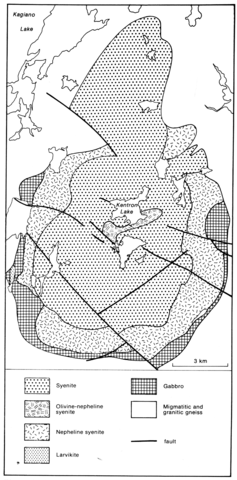stripes
This oval complex of 11x8 km intrudes migmatitic gneisses which have been slightly fenitized with the production of pyroxene. The main rock types are concentrically distributed from marginal and older olivine gabbro through nepheline syenite to syenite. The gabbros are irregularly layered and the syenites have a marked lamination which is conformable to the outer margin. The intrusion appears to be funnel-shaped with the syenites overlying the gabbros. The inner gabbro margin is marked by stockworks of nepheline syenite dykes and numerous gabbro xenoliths lie in the syenite. The gabbro comprises plagioclase (An55-60), olivine, clinopyroxene, often altered to biotite; sulphides and intergrown magnetite and apatite commonly form more than 15% of the rock. At one locality the gabbro is nephelinized. Irregular masses of a hypersthene gabbro occur within the olivine gabbro. The nepheline syenites comprise aligned perthite laths, nepheline, which varies from 15-35% near the gabbro to 5-10% at the inner margin, brown amphibole, aegirine, and variable fluorite and cancrinite. Pegmatitic veins include up to 3% zircon, pyrochlore and tourmaline. The nepheline syenites appear to pass gradationally inwards into nepheline-free syenites but the contact relationships are not clear. The syenites are foliated and locally banded. They comprise perthitic orthoclase, interstitial plagioclase (An22), brown to green amphibole, aegirine-augite, biotite and magnetite. An elongate mass of olivine-nepheline syenite lies towards the centre of the complex and its relative age is in some dispute (Sage, 1975, p. 63). It consists of orthoclase, plagioclase (An30), nepheline, hornblende, pyroxene, olivine and accessory biotite, magnetite, apatite and zircon. A rock described as 'larvikite' by Coates (1970, p. 13) lies on the western margin of the complex. It is an olivine-augite syenite with schiller effects displayed by some feldspars. Olivine and pyroxene-phyric lamprophyres cut the complex and the surrounding migmatites, and a 10 m thick nepheline-cancrinite syenite dyke occurs at Kagiano Lake some 2 km northwest of the complex (Coates, 1970, p. 20).
BELL, K. and BLENKINSOP, J. 1980. Grant 42 ages and initial 87Sr-86Sr ratios from alkalic complexes of Ontario. Miscellaneous Paper, Ontario Geological Survey, 93: 16-23.
CLOSS, L.G. and SADO, E.V. 1982. Orientation overburden geochemistry and Quaternary geology investigations of carbonatite-alkalic complexes in the Prairie Lake and Killala Lake areas District of Thunder Bay. Study, Ontario Geological Survey, 23: 1-65.
COATES, M.E. 1970. Geology of the Killala-Vein Lakes area. Geological Report, Ontario Department of Mines, 81: 1-35.
SAGE, R.P. 1975. Carbonatite-alkalic complexes. Miscellaneous Paper, Ontario Geological Survey, 63: 58-66.

